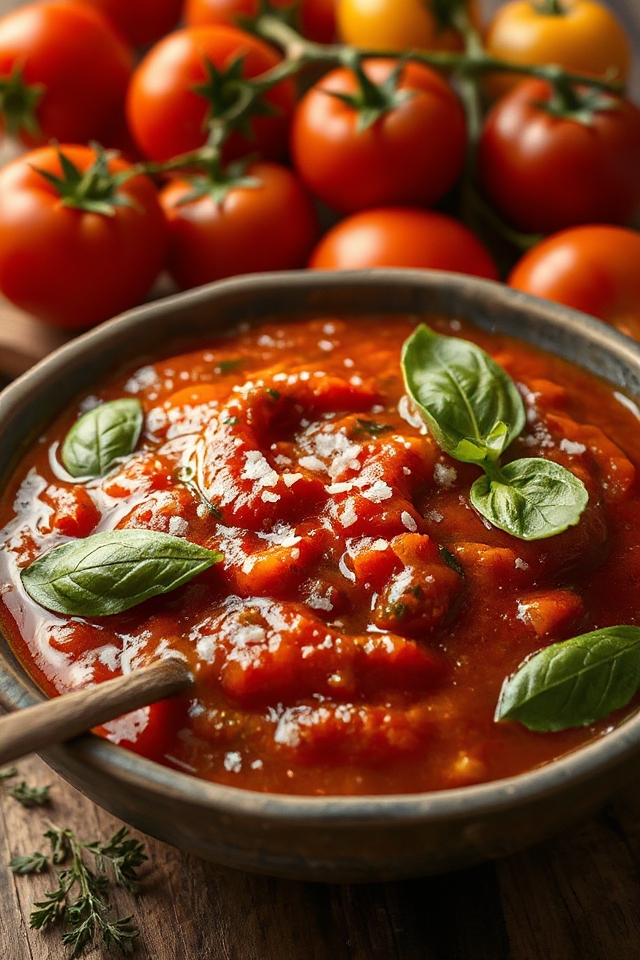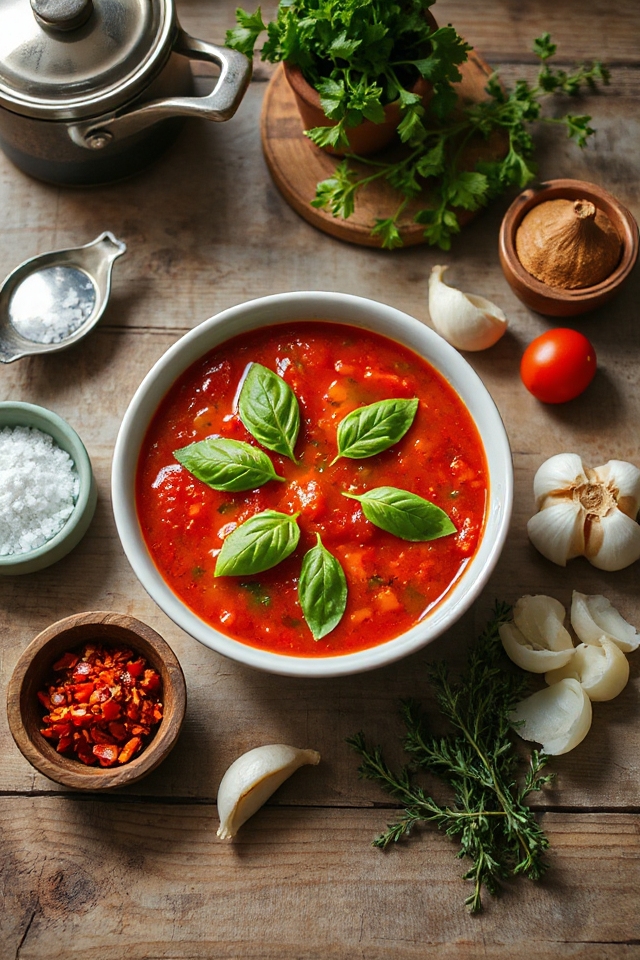Why You’ll Love This Italian Tomato Sauce Recipe
When you taste this Italian tomato sauce, you’ll understand why it’s a staple in my kitchen. The rich, savory flavor envelops your senses, making every dish come alive.
I love how it’s incredibly versatile; whether I’m tossing it with pasta or using it as a base for pizzas, it never disappoints. Plus, it’s so simple to whip up! Just a few key techniques elevate ordinary tomatoes into something extraordinary.
I often find myself making a double batch, because it freezes beautifully. Trust me, once you try it, you’ll be hooked just like I am!
Ingredients of Italian Tomato Sauce
When it comes to making a delicious Italian tomato sauce, the ingredients play a vital role in creating that rich, irresistible flavor. It’s almost magical how a few simple items can come together to make something so comforting and satisfying.
You might be thinking, “Do I really need to use fresh ingredients?” Trust me, they make a difference. Fresh herbs, ripe tomatoes, and quality olive oil can elevate your sauce from good to unforgettable.
So, let’s gather our ingredients and get ready to create something special!
Ingredients for Italian Tomato Sauce:
- 2 tablespoons olive oil
- 1 medium onion, finely chopped
- 3 cloves garlic, minced
- 1 can (28 ounces) whole peeled tomatoes (or about 2 pounds of fresh, ripe tomatoes)
- 1 teaspoon sugar (optional, to balance acidity)
- Salt and pepper, to taste
- 1 teaspoon dried oregano (or a few sprigs of fresh oregano)
- A handful of fresh basil leaves, torn or chopped
- A pinch of red pepper flakes (optional, for a little heat)
Now, let’s chat about the ingredients a bit more. If you can, go for San Marzano tomatoes—they’re like the VIPs of the tomato world.
They’ve that sweet, rich flavor that can’t be beaten. And if you happen to have a garden or a friend with a green thumb, fresh tomatoes will absolutely take your sauce to the next level.
Don’t forget to taste as you go. A little pinch of sugar can work wonders to cut through the acidity, especially if you’re using canned tomatoes.
And those herbs? They’re not just for garnish; they add depth and flavor that will make your sauce sing.
How to Make Italian Tomato Sauce

Now that we’ve gathered our ingredients, it’s time to roll up our sleeves and plunge into the fun part—making our Italian tomato sauce!
First things first, grab your trusty skillet and heat up 2 tablespoons of olive oil over medium heat. The moment that oil starts to shimmer, you’ll know it’s time to add in the finely chopped onion. Sauté those onions gently for about 5 to 7 minutes until they become soft and translucent. Don’t rush this step, okay? This is where the magic begins, and the aroma will fill your kitchen like a warm hug.
Once your onions are looking good, toss in 3 cloves of minced garlic. Now, here’s a little tip: keep an eye on the garlic because it can go from perfectly golden to burnt in a heartbeat. Sauté for just a minute or so until it’s fragrant—trust me, you’ll know when it’s ready.
Next, it’s time for the star of the show: the tomatoes. If you’re using a can of whole peeled tomatoes, crush them gently with your hands as you add them to the pan. If you’re going for fresh tomatoes, chop them up and throw them in. Add in 1 teaspoon of sugar if you’re feeling like your sauce might need a little balancing act; it can really help cut through any acidity. Sprinkle in some salt and pepper to taste—don’t be shy—this is where you can really start to build flavor.
Finally, stir in 1 teaspoon of dried oregano (or if you’re feeling fancy, use fresh oregano) and a handful of fresh basil leaves. Let the sauce simmer gently for about 20 to 30 minutes, stirring occasionally. This is where the flavors meld together, and you’ll be tempted to just grab a spoon and dig right in.
If you like a bit of heat, sprinkle in a pinch of red pepper flakes. Taste as you go, too; you want it to be just right.
And there you have it, a simple yet divine Italian tomato sauce ready to elevate any pasta night. Enjoy it over your favorite spaghetti or as a base for a pizza. Just don’t forget to pat yourself on the back for a job well done because let’s be real, you totally nailed it!
Italian Tomato Sauce Substitutions & Variations
Although traditional Italian tomato sauce is delicious on its own, there are plenty of substitutions and variations you can explore to make it your own.
For instance, try adding roasted red peppers for a smoky flavor or a splash of balsamic vinegar for sweetness. If you prefer a spicier kick, toss in some red pepper flakes.
Fresh herbs like basil or oregano can elevate the taste, while a dash of sugar can balance acidity. You might even experiment with different tomatoes, like San Marzano or cherry tomatoes, for unique flavors.
The possibilities are endless, so let your creativity shine!
What to Serve with Italian Tomato Sauce
Italian tomato sauce is incredibly versatile and can transform a variety of dishes into something special.
I love serving it over al dente pasta, where the sauce clings beautifully to each strand. It’s also perfect as a base for pizza, adding rich flavor that elevates any topping.
When I make stuffed bell peppers or eggplant Parmesan, a generous layer of this sauce makes all the difference. Don’t forget about pairing it with crusty garlic bread for dipping!
Sometimes, I even drizzle it over grilled chicken or fish, creating a delicious fusion of flavors. The possibilities are endless!
Additional Tips & Notes
When making your tomato sauce, keep in mind a few key tips to enhance its flavor and texture.
First, always use ripe, high-quality tomatoes; they’ll make a world of difference.
Don’t rush the cooking process—allow the sauce to simmer for at least 30 minutes to deepen the flavors.
I love adding a pinch of sugar to balance the acidity, but taste as you go.
Fresh herbs like basil and oregano elevate the taste, so consider adding them towards the end of cooking.
Finally, let the sauce cool before refrigerating; it’ll taste even better the next day!
Enjoy your culinary creation!
